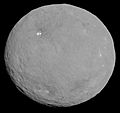Plutoid facts for kids
A plutoid is a special kind of dwarf planet that orbits the Sun much farther away than Neptune. They are also sometimes called ice dwarfs because they are made up of a lot of ice, rock, and frozen gases. These fascinating objects are found in the outer parts of our Solar System, mainly in a region called the Kuiper belt.
Contents
What Are Plutoids?
Plutoids are a specific group of dwarf planets. To be a plutoid, an object must meet a few rules. First, it has to be a dwarf planet. This means it's big enough to be round because of its own gravity, but it hasn't cleared its orbit of other objects. Second, it must orbit the Sun beyond Neptune. This makes them different from other dwarf planets like Ceres, which is found in the asteroid belt between Mars and Jupiter.
Dwarf Planets: A Quick Look
Before we dive deeper into plutoids, let's quickly understand dwarf planets. A dwarf planet is a celestial body that:
- Orbits the Sun.
- Is massive enough to be nearly round due to its own gravity.
- Has not cleared its orbit of other smaller objects.
- Is not a moon of another planet.
There are currently five recognized dwarf planets: Pluto, Eris, Makemake, Haumea, and Ceres. Four of these are plutoids.
Meet the Known Plutoids
As of now, four objects are officially classified as plutoids. They are all located far out in our solar system.
Pluto: The Most Famous Plutoid
Pluto was once considered the ninth planet, but it was reclassified as a dwarf planet and a plutoid in 2006. It is the largest and best-known plutoid. Pluto has five moons, with its largest moon, Charon, being almost half its size. The New Horizons spacecraft visited Pluto in 2015, sending back amazing pictures and information about its icy surface and thin atmosphere.
Haumea: The Fast Spinner
Haumea is unique because it spins so fast that it has an oval shape, not a perfect sphere. It also has a ring system and two small moons, Hiʻiaka and Namaka. Scientists believe a huge collision in the past might have caused its fast spin and created its moons and ring.
Makemake: The Bright One
Makemake is one of the largest known plutoids, and it's quite bright, which means it reflects a lot of sunlight. It was discovered shortly after Easter in 2005, which is why it's named after the Rapa Nui god of fertility and the chief god of Easter Island. Makemake has one known moon, which is much fainter than Makemake itself.
Eris: The Distant One
Eris is the most massive and second-largest known dwarf planet. It is often farther from the Sun than Pluto, making it one of the most distant objects we know in our solar system. Eris has one moon named Dysnomia. Its discovery in 2005 played a big role in the decision to redefine what a planet is, leading to Pluto's reclassification.
Future Plutoids?
Scientists are always looking for new objects in the outer solar system. There are a few other objects that might be classified as plutoids someday if they are confirmed to be dwarf planets. These include:
Why Are They Called Ice Dwarfs?
Plutoids are often called "ice dwarfs" because of what they are made of. Unlike the rocky inner planets (like Earth or Mars) or the gas giants (like Jupiter or Saturn), plutoids are mostly made of ice. This includes water ice, but also frozen methane, nitrogen, and carbon monoxide. Their surfaces are very cold, allowing these gases to freeze solid.
Where Do Plutoids Live?
Most plutoids are found in the Kuiper belt, a vast region of icy bodies beyond Neptune's orbit. The Kuiper Belt is like a much larger, thicker version of the asteroid belt. It's home to thousands of small, icy objects, and it's where many comets come from. Plutoids are among the largest objects in this distant, cold region of space.
Images for kids
-
The dwarf planet Ceres, as imaged by NASA's Dawn spacecraft. Ceres is not a plutoid because it orbits within the asteroid belt, not beyond Neptune.
See also
 In Spanish: Plutoide para niños
In Spanish: Plutoide para niños



